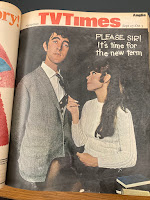On Thursday, 16 January, I received from a kind friend this enormous 500+ page book on the David Lynch version of
Dune — a film we both find extraordinary. It’s a beautiful hardback edition, the pages edge-painted in sparkly red (which impressed both my children). I went on to
Bluesky to enthuse about this gift and discovered Lynch had died. “He’d appreciated the timing,” responded one of my other pals.
I started the book that afternoon but, like the film (and the novel it’s based on), it’s a vast sprawling epic and has taken a while to get through, not least because I’ve had a whole bunch of work stuff going on, too. Evry tells us at the start that he ordered the wealth of information so that we can skip to the bits of interest, whether that’s his detailed histories of pre-production, filming and what happened afterwards, the huge oral history of interviews with cast and crew, or the extra stuff like the merchandise and legacy of this peculiar, beguiling movie. I am hardcore and did the whole lot.
At first, I thought the book might have been better edited, even judiciously pruned, as there’s quite a lot of repetition. But as I read, on the repetition became important to our understanding: these are things on which people agree, in contrast to the many points on which there is less consensus.
Some witnesses, such as costume designer Bob Ringwood, are engagingly gossipy and forthright in their views. Others are more cautious in what they share. That is especially telling when their accounts are combined. For example, there’s the account of one male actor getting into character on set by shouting at and upsetting co-star Francesca Annis. Annis, cited in a contemporary interview (she did not contribute to this new book) declines to name the male actor. But here, publicity executive Paul M Sammon does (p. 223).
This is immediately followed by a contribution from another cast member, Sean Young, who doesn’t name the male actor or refer to the incident specifically. Yet by placing her words directly after Sammon, the implication is that she’s telling us what happened in response on set.
“As an actor, when I’m working with other actors, we all know who’s the deadwood. We all know who it is. We may not say it, but we’ll avoid them.” (p. 224)
There’s loads I found fascinating here. Val Kilmer and Tom Cruise screen-tested for the lead role of Paul. MacLachlan walked off set several weeks into filming because he’d still not received a contract. The rubberised stillsuits created for Dune were a big influence on Michael Keaton’s costume as Batman — also realised by Bob Ringwood — and superhero costumes ever since. Production on Dune overlapped a bit with Conan the Destroyer, using some of the same locations and sets, and at one point you could see both out in the desert on facing dunes. There’s stuff on the music and marketing and merchandise… There is a lot of detail.
These details could have been summarised or more concisely related but that would be missing a big part of the appeal of this book. A bit like the documentary Get Back where we sit day after day with the Beatles, the joy here is all the mundane, ordinary stuff as well. It’s the granular detail that really opens up the creative process. We gain a strong sense of what Lynch was doing, what he tried to achieve and what exactly went wrong.
A few days after receiving the book, I watched the movie with my teenage son, who had seen the Villeneuve Dune and Dune: Part II but came to this old film wholly new. He enjoyed it, I think, and found it interesting to see a different take on the same material, but his main issue was that the last hour or so is too rushed, too much happening too quickly for it to have an emotional impact. That, I now learn from reading this book, is because the production shot largely in script order; when money began to run out, they ripped our whole pages of what they still had to shoot…
Insights into the production and thus what we see on screen only take up the first half of this enormous volume. Evry has just as much interest in what followed, picking over the way the film was released, seen and received. More than that, there’s the sense of how it has haunted (or not) the people who made it.
Now, this is an oral history — it says as such on the cover — and memory can be a bit fallible. Evry does a good job in outlining the history as he understands it and then letting the people involved have their say, whether or not that contradicts the “facts” or other contributors. I think sometimes what people say could do with a little more interrogation. For example, we learn how one particular design was inspired by a trip Lynch made as the guest of producer Raffaella De Laurentiis and her movie mogul father Dino. But we’re told that,
“Dino took him [Lynch] and Raffaella on an impromptu (and speedy) car trip to Venice, arriving directly in St Mark’s Square.” (p. 61).
That’s not technically possible given how Venice doesn’t have roads. Besides, Bob Ringwood then tells us that they all arrived by plane (p. 111).
Since I’m quibbling over small stuff (minuscule!), we’re frequently told of scenes being “lensed” or hear of “lensing” as a synonym for shooting. I don’t think that’s ever in a quotation from cast or crew; it’s a term used by movie journalists rather than those who make movies, not least because you fix or modify a “lens” before you start the action. Referring to Lynch as “the helmer” rather than director is another journalistic cliché, and not quite appropriate in this case since a key element of the story is how Lynch wasn’t in overall charge of what made it to the screen.
At times, the prose is oddly colloquial, too. When discussing the possibility of a director’s cut of the movie, we’re told that Lynch was “initially enthusiastic about taking a mulligan”, which I had to look up (it means when a golfer is allowed to replay a stroke), and then that “the studio refused to pony up the right amount of dough” (both quotations, p. 293). That is quite the mixed metaphor.
I raise this because the book is otherwise so often very good at explaining simply and clearly what were very technical procedures, such as the way the film was financed or the then-pioneering special effects. It makes us understand exactly how ingenious and revolutionary a lot of this stuff was for it’s time, as well as how influential. But also I am a jaded old hack who finds such grammatical stuff distracting and what I really want — in this book, in the film — is to lose myself in the weird, rich world of Dune.
Pedantic quibbling aside, this is an extraordinary, rich and insightful book. I’m tantalised by the details that remain elusive: how much footage actually survives; how possible it would be, with some new effects work, to produce a director’s cut, and how much of a screenplay for Dune II Lynch may have written.
The book ends with a short, sweet interview with Lynch himself, who just wants to say how much he enjoyed working with cast and crew for all he doesn’t much rate the film. My sense is of Evry trying valiantly to keep the call going, to draw more from Lynch and to somehow articulate something of what Dune means to him, the author of this exhaustive book. “Fantastic, man,” says Lynch, cheerily, and ends the conversation.
We’re left hanging. Now we always will be.
See also:





















